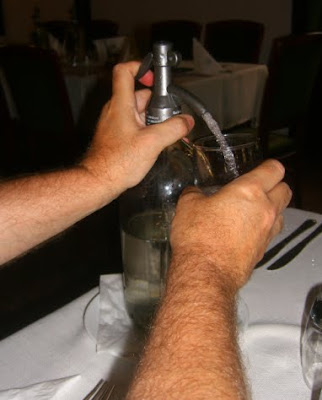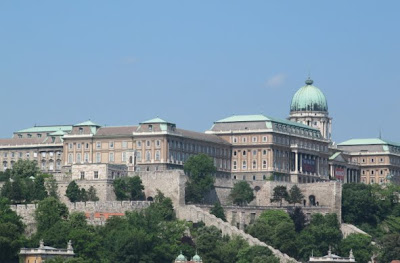On Sunday, first we went to Cafe Gerbeaud, an historic coffee house on Vörösmarty tér, for breakfast.
I settled on the smallest breakfast tray, a croissant and brioche with butter and jam, served with juice and tea.
Keenan tried the next size up, with breads, meats and cheeses, and his typical hot chocolate.
Joren went all in for the big breakfast, with omelet and capuccino.
Afterwards, we headed down the nearby stairs to the metro to make our way to the small town of Szendendre (St. Andrew), a short, 40 minute train ride north of Budapest. Szendendre was crawling with visitors.
The winding and hilly streets were lined with shops selling souvenirs. Billed as an artist colony, I had hoped to find more original work here, but other than an obviously local ceramics studio we found at the end and a few painters doing watercolors on the street, all the work seemed the same to me. Evidently, what sells is the standard tourist attraction work.
I did buy a hand-painted pitcher here for a song. Later I saw work very much like this in the tourist district of Budapest for at least double the price.
Actually there was one gallery with beautiful fused glass work and I bought a small original watercolor of the town there.
We did wander through the marzipan shop and had lunch on the sidewalk (more like street) where we ate gulaz (goulash) soup served in heated kettles with bread.
It was bright, sunny, and warm for our strolls through town, and we stopped along the Danube River at a restaurant advertising lemonade. Very tart, but served with ice (a rarity) -- it was quite refreshing.

One of the more striking differences between both Prague versus Budapest is the state of the infrastructure. Both the Czech Republic and Hungary were Communist until 1989, but it shows more in Hungary. Both have huge blocks of ugly, faceless apartment buildings in their suburbs, but graffiti was rampant in Hungary and there appears to be a slower modernization. Even in the tourist district of Budapest where we stayed, many buildings needed repair. To be fair, Budapest was bombed during WWII whereas Prague was not, but even so, Prague seemed more modern and updated in comparison. The trains in Prague were new and sleek, while those in Budapest were old and bare. We did find the musical notification of stops to be quite charming, reminiscent of a polka, I thought. Overall, Prague seems to have leveraged their economy better to enable them to restore their beautiful originality.
After riding back to Budapest, we rested up for our outing to see a folklore performance in the evening. To save time, I caved to Joren's begging to visit Gusto Burger across the street from our hotel. Listed in some review Keenan read somewhere as a good quality, fair priced local competitor to McDonalds (everywhere!), I sent the boys over for burgers and fries. Evidently Gusto Burger caters more to locals, because English was not to be had. Instead of the three double-meat cheeseburgers (with lettuce and tomato) they tried to order, they came out with six single burgers with ketchup (yuck!). Joren had commented on some table at the local Burger King that we had passed earlier in the day that seemed to have six huge orders of fries, so we laughed now, thinking that perhaps they'd had a similar experience.
We took the metro under the river, and popped up in the square in front of St. Anne's church.
The Rajko Folk Ensemble performance was terrific, consisting of a live orchestra and dancers. The orchestra consisted of eight violins, bass, clarinet and an instrument that we weren't sure about -- a dulcimer, perhaps? They played both classical pieces and gypsy tunes, with great virtuosity. You can watch a performance
here with some of the same performers we watched (younger), filmed in Szentendre. Here's a
version closer to what we saw, in the theater we visited, very small where we had excellent views. The dancers changed costumes for each piece, each one more colorful than the previous. I did find a
clip on YouTube that seems very much like what we saw. Our favorite dance was the bottle dance, where the five women danced with large glass bottles filled with red liquid on their heads, sometimes swapping with their neighbors. Nary a drop was spilled.
After the performance, we walked back along the Danube, taking night photos of the Parliament and Chain Bridge.



















































